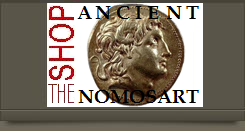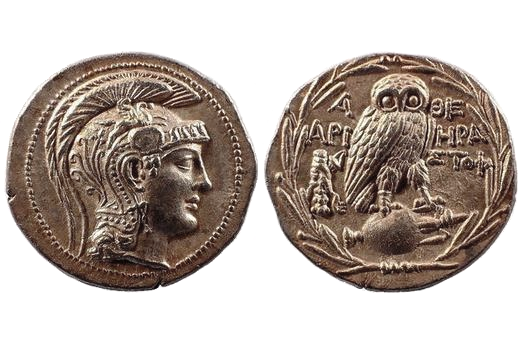
about ancient nomos
Ancient Nomos Art is a museum of galleries exhibiting ancient coins and ancient mint maps. The coin gallery displays the diverse art and history of hand-crafted ancient Greek, Roman, Byzantine, Persian and Medieval coinage. The ancient mints mapping gallery features Greek, Roman, Byzantine, Asia Minor and Medieval mint city regions and territories. Visitor's are welcome to explore, study and enjoy Ancient Nomos Art.

Greek, Attica – 136 BC
Athens
From Ancient Galleries

Obverse: Head of Athena facing right wearing helmet decorated with palmette.
Reverse: Owl standing on panatheniac amphora with head facing, within wreath.
LEGEND SYMBOLS
Obv: Head of Athena Parthenos facing right wearing necklace, pendent earring, and triple crested Attica helmet decorated with the protomes of four horses above the visor, a Pegasus in flight rightward above the raised earpiece, and a curvilinear ornament on the shell; beaded border. Rev: Α-ΘΕ above ΑΡΙ – ΗΡΑ / ΣΤΟΦ Owl standing on horizontal Panatheniac amphora with its head turned facing; club facing downward, draped in lion skin and set over bow in case; all within olive wreath.
Ancient Athens began striking the above so-called “new style” silver tetradrachms following the Roman liberation of the city from Macedonian control in 168 BC. The cities major thematic subject of Athena and her mythological Owl, as found on the original Attica tetradrachm remains unchanged, with the exception of a now larger coin diameter and highly decorative Hellenistic embellishment of the basic design elements. The new obverse portrait of Athena is thought to be modeled after the colossal statue by Phidias found in the Temple Parthenon. She is adorned with a triple crested helmet, tendrils, winged Pegasus and four horse heads. The reverse still depicts Athena’s sacred Owl with head turned facing, but now the Owl stands with talons clutching a Panatheniac amphorae, likely a symbol of the prized olive oil commodity. The previous single olive sprig design is now replaced with a perimeter olive wreath framing the entire design. The olive wreath encircling the Owl, known as the stephanephoroi or the “wreathed” coinage type found throughout Attica and the Delos, is thought to be symbolic of the annual Panathenaic celebrations of Athens, while also reflecting the vast Athenian olive industry. The design is embellished further with the Athenian club, bow in case and Lion’s skin to the left of the amphora, with the Greek ethnic AΘE, or first three letters meaning “of the Athenians” above. To the Owl’s right are two abbreviations for the annual minting authority magistrates Herakles and Aristoph. Typical 136 BC issues find three magistrate legends, but this extremely rare example has the third name of ΠΟΛΥΧ expunged from the reverse die engraving.
DOCUMENTATION
Value: Tetradrachm. Metal: AR Silver. Weight: 16.87 grams. Mint: Athens, Attica. Date: 136-135 BC.
Attribution: M.Thompson, 1961, 330 variety; Giessener Münzhandlung 96, 134; UBS 63, 139.
Legend, Documentation and Attribution
